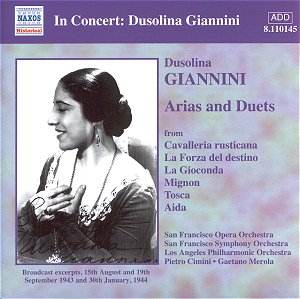Dusolina Giannini was the younger of two opera-singing
daughters of the tenor Enrico, who emigrated from his native Italy
in 1885 and made the first operatic records for Emil Berliner
in 1895. After marriage, he settled in Philadelphia and opened
a small theatre. This is relevant to Dusolina because it was in
that theatre that she sang, at the age of 12 no less, the roles
of La Cieca in ‘La Gioconda’, and Azucena in ‘Il Trovatore’! She
must have had an unusually strong voice for her age, particularly
in the lower registers, to have attempted those roles even in
a small theatre. She made her full debut in a New York concert
in 1923, deputising for a sick colleague, and sang Aida and Santuzza
in Hamburg in 1925 followed by appearances in Berlin, Vienna and
at Covent Garden as Aida. At this stage of her career the big
lyrico-spinto roles seemed to be her fach and in the same year
that she had sung Aida at Covent Garden she recorded the role
with Pertile as Radames. She was viewed as one of the most exciting
‘Italian’ singers of the period alongside contemporaries such
as Cigna, Bruna-Rasa and Caniglia who were singing a similar repertoire.
Giannini appeared at Salzburg 1934-1936 as Donna Anna (Don Giovanni)
and Alice Ford (Falstaff) and whilst the first of those roles
would have utilised her extended vocal range I wonder about the
appropriateness of the second. Giannini sang at The Met from 1935-1942
but making only twenty appearances. In 1938 she sang the role
of Hester in the premiere of her borther, Vittorio Giannini’s
opera The Scarlett Letter (Hamburg, 2 June 1938). She appeared
in many American cities during World War II and appeared again
in Europe 1947-1950.
I give the above in more detail than usual because
the singer’s name may not be as well known to many as that of
Rosa Ponselle, for example, and the other contemporaries mentioned.
Giannini’s voice, with its dark colour, was distinctly different
to that of Ponselle, who can be heard in Verdi on Naxos Historical
8.110728. There her lighter tones, and greater vocal security
are obvious. With Giannini, portrayal of the drama is all, with
evenness of vocal emission or legato taking second place. There
are similarities in her vocal strengths, and weaknesses, to mid-1950s
Callas. Characterisation is all and hang the odd sour note or
ugly sound. In this short measure selection from broadcast performances,
we are able to hear the singer in some of her favourite operatic
roles, and, in addition, in two ballads of which she was fond.
In the singing of these two, now largely forgotten songs, we can
hear the full beauty of Giannini’s voice without her having to
‘ride’ the orchestra, or trying to ‘live’ the emotions of an operatic
part in the cold of a concert performance (trs. 6-7).
The recorded sound is variable between the broadcasts
with the orchestral sound in the first ‘Forza’ extract being rather
constricted, even distorted (tr.1), whilst Rittorna Vincitor from
the 1944 San Francisco broadcast is boxy. The sleeve note, like
the timing is distinctly sparse. As the broadcasts were of concert
performances there is applause, abbreviated, after each item.
As Giannini has an extended recorded legacy on 78s I can only
assume the wish to present her in concert inhibited Naxos Historical’s,
normally generous in timings, from giving more abundant measure.
This disc provides opportunity to hear a dramatic
‘Italianate’ spinto from a period when such voices were commonplace
compared to today. The name may be new to many, but Giannini was
a considerable artist well worth hearing.
Robert J Farr

